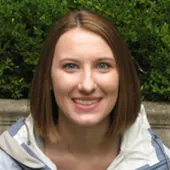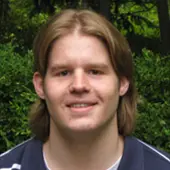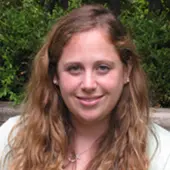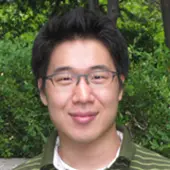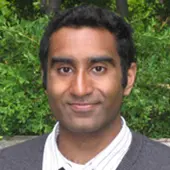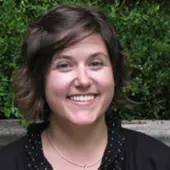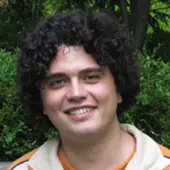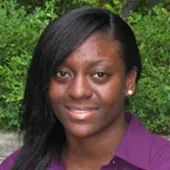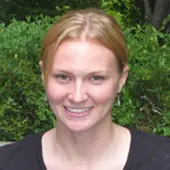2009-2010 Cluster Fellows
Allie Baczynski
Department/Program: Earth and Planetary Sciences
Faculty Advisors: Francesca McInerney
Status of Studies: Fourth Year
What is your area of focus at Northwestern?
I am investigating a major perturbation to the global carbon cycle, the release and re-absorption of a massive amount of carbon into and out of the atmosphere, which occurred ~55.8 million years ago at the Paleocene-Eocene boundary. This event, known as the Paleocene-Eocene Thermal Maximum, resulted in rapid, transient, and large-scale global warming and is recognized as the warmest period of the Cenozoic Era. The Paleocene-Eocene Thermal Maximum is an important event to study because it can be used as an analogue to modern anthropogenic carbon release and carbon sequestration. My graduate research involves using the carbon and hydrogen isotope ratios of leaf-wax lipids extracted from fossil soil samples to reconstruct terrestrial paleohydrology across the Paleocene-Eocene boundary. I spent the summer of 2010 in the Bighorn Basin, Wyoming collecting ancient soil samples from the Paleocene-Eocene Thermal Maximum. Since the summer, I have been analyzing these samples in the organic geochemistry laboratory in order to evaluate the consequences this extreme global warming had on the water cycle. I will head back to Wyoming in the summer of 2011 to continue collecting samples.
Brief personal history:
I grew up in Penacook, NH and finished high school in New Richmond, WI. I graduated from Macalester College, Saint Paul, MN in May 2007 with a degree in chemistry. I developed an interest in geology during my last two years of college and spent a year after graduation doing geology fieldwork. This experience inspired me to apply to geology graduate programs, which ultimately lead me to the Earth and Planetary Sciences Department at Northwestern University.
Why were you interested in becoming a Cluster Fellow?
I applied for the Cluster Fellowship because of the opportunity to work and interact with a group of graduate students from many different departments with different academic interests and backgrounds. I was excited to be a part of group of students interested in energy and sustainability, in helping the Institute to expand their prominence on campus, and to advance its mission to create and communicate new science, technology, and policy for sustainability and energy.
The highlights of this year's experience were:
I passed the qualifying exam in late spring and delivered my first oral presentation at the American Geophysical Union fall meeting in December 2010.
Spending last summer in the Bighorn Basin, WY as part of a large team of scientists participating in the Bighorn Basin Coring Project. We collected a series of continental cores through the PETM to better characterize the sedimentological and geochemical changes across this global warming event. The cores were shipped to Bremen, Germany, where I spent the month of January collecting samples for my research.
This experience has enriched my time here at Northwestern by:
-Encouraging me to take courses and attend and participate in events I wouldn’t otherwise have known about or taken part in.
-Allowed me to meet and work with a wonderful group of graduate students and faculty that spanned many different disciplines and academic interests.
My future plans include:
Returning to the Bighorn Basin, WY this summer to continue fieldwork and collecting samples for my research. Continuing my research on the path towards my PhD! Continuing to analyze samples that were collected last summer and publish the results.
Updates:
I presented at three conferences in the past year as well as gave a talk at the Washakie Museum and Cultural Center in Worland, Wyoming as part of the Bighorn Basin Paleontology Symposium, where the community was invited to come find out about what all the scientists who come into town every summer are studying.
Cary Hayner
Department/Program: Chemical and Biological Engineering
Faculty Advisor: Harold Kung, Walter P. Murphy Professor of Chemical and Biological EngineeringStatus of Studies: Fourth Year
What is your area of focus at Northwestern?
My research focuses on the advancement of lithium-ion batteries for energy storage technology. Lithium-ion batteries, which are the most preferred energy storage technology for portable electronics, are also the most promising to capitalize on emerging markets such as transportation, medical, military, and advanced portable electronics. In my research, I am looking at new materials to improve the energy density and cycling stability of the negative electrode for new energy-intensive applications. Currently, the negative electrode utilizes a graphite material, which provides limited capacity but stable cycling performance. One promising candidate to replace graphite (and other carbon material) is silicon, which has the highest theoretical energy density of any common element, and is also cheap and abundant. Unfortuantely, silicon – which can hold roughly ten times more energy per gram than graphite - expands and contracts during operation, leading to an electrode that degrades over time and diminishes its performance. To overcome this degradation, we are researching advanced silicon-carbon composites using nanomaterials to minimize the capacity loss and increase the cycling stability. With sufficient stabilization, these materials will be able to significantly improve the performance of lithium-ion batteries for emerging energy-intensive markets.
Brief personal history:
I was born and raised in Blaine, Minnesota, a suburb of Minneapolis known for its soccer fields and golf courses. Growing up, I received lots of encouragement from my parents to pursue my scientific interests and always competed with my two brothers for attention. I attended the University of Minnesota for my undergraduate education, where I earned degrees in chemical engineering and chemistry. I graduated in 2008, and have attended Northwestern ever since.
Why were you interested in becoming a Cluster Fellow?
I was interested in becoming a Cluster Fellow because I felt it would be a great opportunity to learn more about sustainability. I was also really impressed with the Institute’s mission and their focus was in line with my interests.
The highlights of this year's experience were:
I really enjoyed being able to lead discussions with undergraduate students of various backgrounds and educations. I felt that it was a great experience to teach students about a variety of technology topics and how sustainable ideas can be applied to systems. I also had a blast listening to the invited speakers that the Institute helped co-host over the past year (especially Robert F. Kennedy, Jr. and Jean-Michel Cousteau).
Since the end of my tenure as a Cluster Fellow, I have presented at two conferences (American Institute of Chemical Engineers (AIChE) Midwest, and AIChE Annual) focusing on developing novel anode (negative) electrode material consisting of graphene and silicon, (among other materials) to fairly large audiences (up to ~80 people). I have also completed my PhD Proposal Defense (Qualifying Exam) on December 13th, 2010, making me a 'PhD Candidate' and one step closer to my thesis completion. Our group is also in the process of writing and revising multiple publications.
This experience has enriched my time here at Northwestern by:
…providing me the invaluable opportunity to meet people, network outside of my specialized field, and learn an incredible amount about a variety of topics related to sustainability.
New things I learned about myself or others this year:
I got a much better grasp of the extremely large amount of work people are doing around Northwestern and beyond on sustainability-related projects. There are incredible undergraduate and graduate student groups here that are pushing for a cleaner future, and a vast amount of research that will help accomplish some of those objectives. I was impressed learning about how each Cluster Fellow helped contribute to the advancement of their respective field and the health of the planet.
My future plans include:
Completing my PhD while making incredible advancements in energy storage technology! While not researching, I hope to travel and explore more of the outdoors while I have the time. After graduation, I hope to have the opportunity to continue on researching topics that I find important (energy storage and renewable energy generation) whether it be academically or industrially. If possible, maybe eventually start up a non-profit company with some amazing yet-to-be-thought-up idea…
Publications:
- C. M. Hayner, X. Zhao, H. H. Kung, “Materials for Rechargeable Lithium Ion Batteries.” Annu. Rev. Chem. Biomol. Eng., 2012 3, 445-471.
- X. Zhao, C. M. Hayner, M. C. Kung, H. H. Kung, “Flexible Holey Graphene Paper Electrodes with Enhanced Rate Capability for Energy Storage Applications.” ACS Nano, 2011, 5 (11), 8739-8749.
- X. Zhao, C. M. Hayner, M. C. Kung, H. H. Kung, “In-Plane Vacancy-Enabled High-Power Si-Graphene Composite Electrodes for Lithium-Ion Batteries.” Adv. Energy Mater., 2011, 1 (6), 1079-1084.
- X. Zhao, C. M. Hayner, H. H. Kung, “Self-assembled lithium manganese oxide nanoparticles on carbon nanotube or graphene as high-performance cathode material for lithium-ion batteries.” J. Mater. Chem., 2011, 21 (43), 17297-17303.
- J.-K. Lee, K. B. Smith, C. M. Hayner, H. H. Kung, “Silicon nanoparticles-graphene paper composites for Li ion battery anodes.” Chem. Commun. 2010, 46, 2025-2027.
Updates:
Cary serves as the CTO for SiNode Systems (spun out of ISEN 430 NUvention: Energy course project in Winter 2012) which was named National Category Winner for Energy Efficiency at Clean Tech Open (Nov 2012) and won both the Rice Business Plan Competition, ~$900k (Apr 2013) and the DOE Clean Energy Business Plan Competition (Jun 2013). SiNode Systems was recently awarded a $4M project with USABC (U.S. Advanced Battery Consortium consisting of Ford, Chrysler, and GM) to develop battery materials for EV applications.
He was named a "2016 Forbes 30-Under-30" awardee in the Energy category, and a “2017 All Star Alumni.” Cary also became “Co-Founder” of SiNode Systems (NanoGraf Corp SiNode Systems started a Joint Venture with JNC, a Japanese chemicals company, and re-branded as NanoGraf Corporation). NanoGraf Corporation was awarded a new three year, $7.5M grant from USABC - a consortium of Ford, FCA, GM, and the Department of Energy.
Allison Juster
Department/Program: Mechanical Engineering
Faculty Advisor: Horacio Espinosa,
James N. and Nancy J. Farley Professor in Manufacturing & Entrepreneurship; Director, Theoretical and Applied Mechanics Program; Director of the Institute for Cellular Engineering Technologies; Professor of Mechanical Engineering and (by courtesy) Biomedical Engineering and Civil and Environmental EngineeringStatus of Studies: Second Year
What is your area of focus at Northwestern?
My research primarily focuses on the creation of bio-inspired materials. By this I mean mimicking structures in nature to produce man-made materials. Research has shown that natural materials exceed in performance compared to engineered materials. By analyzing mechanisms in natural materials, we can translate these mechanisms to synthetic materials, thus creating higher performing man-made materials. Currently I am involved in two projects. The first involves understanding the failure mechanism of nacre from Abalone shells. Nacre is comprised of 95% ceramic and 5% polymer, yet is not brittle in nature (ie it has a high strength and elongation until failure). However, in nacre, these mechanisms are across many length scales ranging from the nanoscale to the macroscale. By characterizing the important mechanisms in natural nacre, I was able to translate these into a man-made composite. With the addition of these toughening mechanisms, I was able to create a stronger, tougher composite. My second research topic involves characterizing carbon nanotube-polymer yarns. Ideally we would like to incorporate mechanisms that we have seen in nacre to increase the performance of these yarns. Currently I am developing a fiber spinning machine to machine these fibers. From here I will perform tensile tests on the fibers to analyze their failure properties. In the future, we hope to add certain mechanisms from nacre to increase the strength and elongation to failure of these yarns.
The end goal of all of these projects is to develop light-weight composites that can be used to increase efficiency in many areas such as transportation and aerospace. We can also apply these materials to defense as we are trying to improve energy dissipation characteristics as well.
Brief personal history:
I was born in Riverside, CA and lived in CA for six years until moving to Indianapolis, IN which is my current hometown. I have a younger brother who just graduated from Emory University. I have always played sports, but my main sports in high school were tennis and golf. I ended up attending Lehigh University where I played on the women’s varsity golf team and also majored in Mechanical Engineering. I received my Bachelor’s of Science from Lehigh in the spring of 2008.
Why were you interested in becoming a Cluster Fellow?
I was interested in becoming a Cluster fellow because I wanted to meet students in other departments who had similar interests in sustainability and energy. I also wanted to become proactive in the Northwestern, Evanston, and Chicago communities to promote awareness on these issues.
The highlights of this year's experience were:
This year I was published in three journals: “Lessons in Abalone Shell Toughness Applied to Synthetic Materials.” Nature Communications; “Dimensional Analysis and Parametric Studies for Designing Artificial Nacre.” Journal of the Mechanical Behavior of Biomedical Materials; and “Multiscale in situ experiments toward identifying damage and fracture mechanisms on natural nacre.” Experimental Mechanics. Further, I presented at three conferences: “Novel Synthetic Material Mimicking Mechanisms from Natural Nacre” at the Society of Experimental Mechanics Annual Conference on Experimental and Applied Mechanics in Indianapolis, IN, June 2010 and again at the 16th Annual U.S. National Congress of Theoretical and Applied Mechanics at State College, PA, July 2010. Also at State College, “A Dimensional Analysis Framework for Designing Bio-inspired Composite Materials through Modeling and Experiments.” I enjoyed time as a TA for the course ISEN 410 in the fall quarter of 2010 and served in a leadership position in the student group ISENse.
This experience has enriched my time here at Northwestern by:
I have learned that my passion is promoting sustainability and reducing energy consumption. Through the Institute I have learned an extensive amount about the world’s energy crisis and have been able to get involved in organizations that are trying to make a difference. Because of the Institute I have joined CGE (Citizens for a Greener Evanston) and have promoted awareness of our energy crisis through a carbon footprint calculator. We have set up stations at various places in Evanston and use a one minute carbon footprint calculator to give residents an idea of their carbon footprint, and then tips on how to reduce this.
New things I learned about myself or others this year:
I have learned that I would like to have a job that relates to energy or sustainability. Throughout this year, my passion for changing the way we live has increased. I would really like to get involved in companies or programs that are trying to address our energy crisis.
My future plans include:
I would eventually like to teach, but before that I would like to work in industry and hopefully at an architecture firm that is developing green buildings.
Updates Since 2011:
I am currently working for Boeing in Portland, OR as part of their research and technology division (BR&T). I work on the site sustainability team and am responsible for implementing plastics recycling on site. Currently we are 93% complete on our zero-waste to landfill goal. I am also trying to receive my LEED AP in Existing Building Operation and Maintenance (EBOM) because we would like to update our existing buildings to a LEED Silver equivalent. Currently we just opened our LEED Gold Chemical Plating facility, the first in the world to do chemical processing at a LEED standard.
Jaemyung Kim
Department/Program: Materials Science and Engineering
Faculty Advisor: Jiaxing Huang, Adjunct Professor of Materials Science and EngineeringStatus of Studies: Fifth Year
What is your area of focus at Northwestern?
I am studying on graphene and graphene oxide, which is a promising new material that could be used for transparent electrodes in flexible electronics. I am mainly focusing on a chemical imaging of this new material and its assembly behaviors at various interfaces.
Brief personal history:
I was born and raised in Seoul, Korea. I have two sisters, and I am the youngest in my family. As other Korean, I served in military for two years. I’ve been in the United States since 2008 and having a lot of fun since then.
Why were you interested in becoming a Cluster Fellow?
Sustainable energy has been a big issue in recent years, and many science/engineering research efforts have been devoted to developing/improving a technique to harvest energy from nature, i.e., solar cells. As an engineering graduate student, I thought that the Institute would provide me a good opportunity to meet friends with various backgrounds who share common interest in sustainable energy, and form a constructive relationship for both research and general life as a graduate student.
The highlights of this year's experience were:
This year I was published in three journals:
- Jaemyung Kim, Laura J. Cote, Franklin Kim and Jiaxing Huang* "Visualizing Graphene Based Sheets by Fluorescence Quenching Microscopy", Journal of the American Chemical Society, 2010, 132, 260-267
- Jaemyung Kim, Franklin Kim and Jiaxing Huang* "Seeing Graphene Based Sheets", Materials Today, 2010, 13, 28-38
- Jaemyung Kim, Laura J. Cote, Franklin Kim, Wa Yuan, Kenneth R. Shull, and Jiaxing Huang* "Graphene Oxide Sheets at Interfaces", Journal of the American Chemical Society, 2010, 132, 8180-8186
Also, I was awarded the IIN Outstanding Researcher Award (2010) and the Ryan Fellowship (2010-2013).
This experience has enriched my time here at Northwestern by:
I got to know many good friends!
New things I learned about myself or others this year:
I learned that it’s possible to come school at 9 am everyday. I learned my new interest in basic science, which motivated me to pursue a postdoc position after graduation.
My future plans include:
I will be starting my postdoc appointment at UCLA this September. In couple of years, I hope to start my own research group.
Additional Publications:
- Jaemyung Kim, Segi Byun, Alexander J. Smith, Jin Yu and Jiaxing Huang "Enhanced Electrocatalytic Properties of Transition-Metal Dichalcogenides Sheets by Spontaneous Gold Nanoparticle Decoration" Journal of Physical Chemistry Letters, 2013, 4, 1227-1232.
- Stanley S. Chou, Mrinmoy De, Jaemyung Kim, Conner Dykstra, Jiaxing Huang and Vinayak P. Dravid "Ligand conjugation of chemically exfoliated MoS2" Journal of the American Chemical Society, 2013, DOI: 10.1021/ja310929.
- Stanley S. Chou, Bryan Kaehr, Jaemyung Kim, Brian Foley, Mrinmoy De, Patrick Hopkins, Jiaxing Huang, C. Jeffrey Brinker and Vinayak P. Dravid "Chemically Exfoliated MoS2 as Near-Infrared Photothermal Agents" Angewandte Chemie International Edition, 2013, DOI: 10.1002/anie.201209229.
- Alvin T. L. Tan,* Jaemyung Kim,* Jing-Kai Huang, Lain-Jong Li and Jiaxing Huang "Seeing 2D Sheets on Arbitrary Substrates by Fluorescence Quenching Microscopy" Small, 2013, DOI: 10.1002/smll.201300049. (*equal contribution)
- Jiayan Luo, Jaemyung Kim and Jiaxing Huang "Material Processing of Chemically Modified Graphene: Some Challenges and Solutions" Accounts of Chemical Research, 2013, DOI: 10.1021/ar300180n.
Brian Leung
Department/Program: Electrical and Computer Engineering
Faculty Advisor: Seda Ogrenci Memik, Professor of Electrical and Computer Engineering, Computer ScienceStatus of Studies: Third Year
What is your area of focus at Northwestern?
Although many may not realize it, memory systems inside servers are one of the major culprits of power consumption—both directly and indirectly. Servers often run 24/7 throughout the year and directly consume power in normal operation. Besides consuming electricity directly due to regular operation, the memory systems in the servers also generate heat. Thus, the air conditioning in server rooms has to run 24/7 throughout the year to keep the servers cool and prevent damage. Our particular work aims to reduce power consumption and heat dissipation of the memory systems within servers to lower both the direct and subsequently indirect power consumption.
Brief personal history:
Learn more about global warming issues and climate change. It’s a good break from my own research and good opportunity to broaden my knowledge. In grad school, things seem more specialized, and you no longer take a broad topic of courses as in college so ISEN was a good opportunity to do that.
This experience has enriched my time here at Northwestern by:
Introducing me to a lot of awesome new people, learn more about global issues, and learn about research going on in other departments.
Alok Tayi
Department/Program: Materials Science & Engineering
Faculty Advisor: Samuel I. Stupp,
Board of Trustees Professor of Materials Science,Chemistry, Medicine, and Biomedical Engineering; Director, Simpson Querrey Institute
Status of Studies: Completed PhD
What is your area of focus at Northwestern?
My research interests are in the area of supramolecular materials. In other words, I work with molecules that are pre-programmed to spontaneously form structures. I am employing these structures to create low-power computer memory, coatings for biomedical devices, and low-cost solar energy.
I recently completed a Postdoctoral Fellowship with George Whitesides at Harvard University. I was previously a Visiting Scholar, JSPS Fellow at the University of Tokyo in the lab of Professor Takuzo Aida. His research interests are at the intersection of supramolecular chemistry, energy, and health.
I am also the Co-founder and CEO of an Internet-of-Things startup called TetraScience, which connects scientific instruments to the web to enable researchers to remotely monitor their experiments, log data, and receive error notifications. The firm now has approximately 10 employees and is based in Boston.
Brief personal history:
I grew up in Niskayuna, NY. I was first exposed to scientific research while working at Albany Nanotech (now the College of Nanoscience and Engineering) where I worked on quantum dot chemical sensors. That experience convinced me to pursue a degree in engineering. There after I received my B.S. Cum Laude with Honors at Cornell University in Materials Science & Engineering.
Why were you interested in becoming a Cluster Fellow?
The Institute’s strength is derived from networking diverse and talented people across Northwestern. I became a Cluster Fellow to connect with interesting folks from the university and participate in a dynamic, fast-growing initiative.
The highlights of this year's experience were:
My favorite time was working with other Cluster Fellows and the Medill School on Advanced Science Journalism. As a graduate student in the sciences, I would explain to Journalism students the details and implications of my research. The experience helped me better articulate my research to a non-technical audience.
This experience has enriched my time here at Northwestern by:
Pursuing a PhD can result in tunnel vision: you become very focused on your specific area of research. However, being a part of the Institute helped to broaden my exposure to experts and knowledge in the fields of energy and sustainability. I am now able to rationalize how my work fits into the larger picture.
My future plans include:
Upon graduation, I hope to obtain a post-doctoral fellowship in a large research group and eventually pursue a faculty position at a top engineering program.
Other thoughts:
Scientific research is often described as an individualistic effort; however, collaboration, communicating effectively, and leading small teams are vital to accomplishing high impact research. The aforementioned are just as important as technical skills.
Publications:
Alok published a paper in Nature in August 2012. He pursued much of this work while an ISEN fellow. The paper can be viewed here.
Elizabeth Ulion
Department/Program: Science Writing and Reporting
Faculty Advisor: Abigail Foerstner, Associate Professor of JournalismStatus of Studies: Third Year
What is your area of focus at Northwestern?
In my time at Medill I have focused my studies on environmental reporting. I covered the climate change beat for Medill Reports and wrote stories on topics ranging from environmental education to local ecosystem restoration.
Brief personal history:
I grew up in the suburbs of Albany, NY where I spent my summers searching for bugs in my mother’s garden and watching Captain Planet episodes. This inspired me to complete a Bachelors Degree in Environmental Studies from SUNY College of Environmental Science and Forestry. After school I moved to a small town in the California foothills of the Sierra Nevada for a year spent as an AmeriCorps volunteer. There, I was able to combine my passion for the environment with writing which led me to pursue a degree in journalism.
Why were you interested in becoming a Cluster Fellow?
As a journalist you need to learn everything about a topic quickly. I saw the Cluster Fellowship as a way to continue learning about important issues of the day.
The highlights of this year's experience were:
The highlight of this year for me was meeting the other fellows. I now have nine new friends who just happen to be experts in advanced scientific fields.
This experience has enriched my time here at Northwestern by:
This fellowship allowed me to take courses that pushed me beyond the curriculum of the journalism program. I was able to work with a variety of people in different disciplines that I would never have met otherwise.
New things I learned about myself or others this year:
I can do math. Writers are often coddled when it comes to numbers, but in the ISEN courses it was just expected to complete a few simple calculations. Now, I take my calculator out with pride, not fear.
My future plans include:
Working toward my career goal of writing about environmental issues in the form of freelance journalism or non-profit communications.
I achieved a position as a Grant Writer at the Lincoln Park Zoo. I am looking forward to securing funding for conservation research and innovative environmental education.
Other thoughts:
I encourage students in non-science programs to apply for this fellowship. Energy and sustainability are the issues of the day. It’s essential that people across disciplines can understand and communicate about these topics. Apply!
Ömer Verbas
Department/Program: Civil and Environmental Engineering/Transportation Systems Analysis and Planning
Faculty Advisor: Hani S. Mahmassani, Professor of Civil and Environmental and (by courtesy) Industrial Engineering and Management Sciences Engineering; William A. Patterson Distinguished Chair in TransportationStatus of Studies: Second Year
What is your area of focus at Northwestern?
The purpose of our research is to integrate new approaches to fuel consumption and pollutant emission into traffic simulation models, to create a methodological platform capable of evaluating the energy and environmental impacts of network traffic management strategies. Through my studies I have found that our platform is capable to include various vehicle specifications, which have significant effects on emission rates: Fuel type, engine technology, regulation class, model year, engine size, weight class, and age group. According to these specifications and the operating mode of a vehicle; amounts of fuel consumption and running exhaust emissions of carbon dioxide (CO2), carbon monoxide (CO), oxides of nitrogen (NOx) and total gaseous hydrocarbons (THC) can be estimated in a network by running our Mesocopic Dynamic Traffic Assignment (DTA) software DYNASMART-P.
Brief personal history:
I was born and raised in Istanbul, Turkey. After finishing my primary school, I earned the chance to study at German High School, Istanbul for my junior high and high school periods. After that, I earned a BS degree in Mechanical Engineering at Boğaziçi University, Istanbul and an MS degree in Civil Engineering, Transportation program at Istanbul Technical University. In September, 2008 I have arrived in the US to begin with my PhD studies.
Why were you interested in becoming a Cluster Fellow?
From early ages on, I have been raised as an environmentally conscious person by my family and at school. This was enriched with my growing sensitivity towards cultural and historical heritage, which started at the latter days during my BS studies. Being a citizen of Istanbul, a city that hosted three great empires and many other civilizations, a desire to preserve environmental and cultural values guided me into the idea of studying transportation. I have always been seeing transportation as a very strong tool for designing cities and shaping urban life. This brought me to write my MS thesis about the sustainability of the transportation system in Istanbul. Since I wanted to increase my experience and my intellectual knowledge on environmental issues to a more advanced level, I was interested in becoming an ISEN fellow with the support of my advisor.
The highlights of this year's experience were:
A paper I co-authored in IEMS 489 (Transportation Network Design & Operations) regarding Emissions and the Vehicle-Routing Problem is being prepared for submission/presentation at the Transportation Research Board 2012 Annual Meeting. (Vehicle Routing Problem (VRP) is an optimization technique mainly used in logistics to minimize customer and supplier costs. We have included emission costs in the problem, and used a method called Continuous Approximation (CA) to solve it).
This experience has enriched my time here at Northwestern by:
Although, in my opinion, the ISEN 410 class could have been more technical and advanced, I still believe that I have gained valuable introductory information about energy sources both from and environmental and economic point of view.
Although I was not able to join every meeting due to conflicts with my class schedule, it was very good to see that there are many people in the US concerned about the environment and actively working towards solutions and improvements. Observing the interaction between the Institute, other school groups, students and people from Evanston community helped me to see the organizational skills of people at Northwestern, and generally speaking in the US.
Being able to see other student groups’ works and having the chance to learn from them was a good experience. Cousteau’s speech, which was the highlight of the day, was also very teaching. He has not only made us aware of the problems under water but has provided positive examples of how things can be made better with a reasonable amount of effort and investment. There are many people who can see and tell that our future is in danger but there are less people who can make constructive criticism leading to a potential solution. At the personal level, the feeling of providing help for a very important organization was gratifying.
New things I learned about myself or others this year:
I have learned that there is a rapidly growing and already very substantial academic knowledge about environmental issues in the US, and that there are many academic or non-academic people concerned about these issues. However, I have also seen that there is a conflict between these studies and the daily life in the US. As an example, since automobiles and fuel are very cheap compared to many other countries, there are too many SUVs. Or due to low electricity rates, apartment buildings have the lights on 24/7. In that sense, many developing countries are doing “better” in terms of the environment, but sadly because the cost of owning and using cars, as well as the cost of electricity is higher there. It is worrisome to observe that money can be a very strong incentive to improve problems.
Observing the above mentioned fact about the majority of people has brought me to more down to earth, maybe from a slightly unrealistic idealism to a more practical, and solution-oriented point of view.
My future plans include:
Finish my PhD studies and become an academician who is also doing consultancy.
Vennesa Williams Jansma
Department/Program: Chemistry
Faculty Advisor: Joseph T. Hupp,
Charles E. and Emma H. Morrison Professor of Chemistry; and
Michael J. Pellin,
Acting Director of the Division of Materials Science, Argonne National LabStatus of Studies: Completed Program
What is your area of focus at Northwestern?
Towards New Photoanode Architectures in Dye-Sensitized Solar Cells Based on Atomic Layer Deposition (ALD)-Modified SiO2 Aerogels. The aim of this project is to develop a thin film, co-axial photoanode architectural design based on ZnO ALD-modified SiO2 aerogels where these new photoanodes are potentially practical for large scale dye-sensitized solar cells (DSSCs) as they possess exceptional porosity, quasi-one dimensionality and easy infiltration of electronically complementary materials. They also have high and controllable surface areas for sensitizer attachment and essentially no inactive volume. The altered connectivity with aerogels promises charge-pathway redundancy while having a low density, low dielectric constant, and a low thermal conductivity. Optimized ZnO devices with an overcoat of TiO2 has shown improved photocurrents, photovoltages, electron lifetimes and fast electron transit times when compared to similar aerogel devices with pure ZnO. In addition, the stability of ZnO photoanodes protected by this thin shell of TiO2 (deposited by ALD) against the well known corrosive nature of the acidic Ru-dyes towards ZnO materials applied in DSSCs will be demonstrated, and hence the proposed fast electron transport through the ZnO-aerogel framework will be shown.
Brief personal history:
I was born and raised on the tiny Caribbean island of Jamaica in a single parent household with two older brothers. Since then I have been dubbed “The Curious One” with an avid interest in science, and with no one in my immediate community to provide the answers I sought, I quickly jumped on the opportunity to be able to study at the tertiary level here in America. I pursued my undergraduate career at St. John’s University (SJU, Jamaica, NY) where I majored in Chemistry. There I was an IMSD scholar (ie. The Initiative for Maximizing Student Development) and the goal of the program is to increase the number of students from underrepresented groups in biomedical, physical and behavioral research who will complete Ph.D. degrees in these fields. The program offers an opportunity to develop new or expand existing effective academic developmental programs, including student research internships, in order to prepare students from underrepresented groups for competitive research careers and leadership positions in the biomedical, physical or behavioral sciences. In the IMSD Program, I conducted research in the laboratory of Prof. Elise Megehee on the synthesis and characterization of alkyl complexes containing the bis diimine carbonyl osmium (II) moiety and specifically studying the effect of substituted phenanthroline ligands. I was later appointed a member of the Leadership Alliance (a consortium of 33 institutions based at Brown University), and through this alliance, I interned at Stanford University, working on the electrochemistry of copper complexes with substituted phenanthroline ligands covalently attached to graphitic surfaces via “click chemistry”, for uses in fuel cells. My interests in energy thus led me to Northwestern to conduct research on understanding how to harvest the energy we can obtain from the sun.
Why were you interested in becoming a Cluster Fellow?
The quality of human life depends to a large degree on the availability of energy and this is threatened unless renewable energy resources can be developed in the near future, and science is expected to make important contributions to identify environmentally friendly solutions of the energy problem we now face globally. However, I believe that this problem is larger than just science or engineering and it is collectively through education, innovation, and collaboration that we can begin to tackle such a challenge… that is what the Institute is all about! The Institute was developed to create, educate, advance and communicate new science and technologies for sustainability and energy through a campus-wide effort with the hope of pooling the intellectual capabilities from all of Northwestern’s students, and channeling all our efforts in one direction to aide in a solution to our common problem. The collaborative efforts of the Institute throughout the NU community are not the only factors that attracted me to the program, but also the long-term partnerships the organization holds are definite measures for the success to its mission especially through its Fellows. Partnerships for research and education with Argonne National Laboratory, other industries, educational institutions, local resources like libraries and churches are all a part of the organization’s efforts to increase NU’s energy impact, and if I am a part of the problem we face, being a part of the solution is a big step in moving forward.
The highlights of this year's experience were:
- From a learning perspective… Mostly saturated in the events sponsored by the Institute. Most memorable to me are the Solar Conferences conducted jointly with Argonne National Labs. I have learned a great deal from the wide array of speakers who have presented at these conferences, who all represent different fields of study in their quest for the use and understanding of solar power.
- From an involvement perspective… I am grateful to have been a part of the One Book committee which carefully executed its mission by creating a common conversation across campus. The planning and team building skills gained here will definitely be incorporated in my character. Also, being Cluster Fellow Teacher Assistant (TA) was an incredible experience because I was able to demonstrate my ultimate passion for teaching. From the knowledge gained in courses, I was able to formulate all that I had learned into a student’s perspective to effectively help in the understanding of the students in the course I aided to instruct.
- From a research perspective…I have published my findings to the American Chemical Society’s ACS Nano peer reviewed journal. Title: “Fast Transporting ZnO‐TiO2 Coaxial Photoanodes for Dye‐Sensitized Solar Cells Based on ALD‐Modified SiO2 Aerogel Frameworks.” Further, I was awarded for Outstanding Poster at the 4th International Conference on the Industrialization of Dye‐Solar Cells in Colorado Springs, Colorado, November 2010 for that work. Also, I was named a Carl Storm Underrepresented Minority Fellowship to support my participation in the 2011 Renewable Energy: Solar Fuels Gordon Research Seminar, January, Ventura, CA. I was also awarded “Best Poster” at the 5th Annual Argonne-Northwestern Solar Energy Research (ANSER) Center Symposium 2012, presented a poster on work completed at the U.S. Department of Energy, ANSER Center Science Review in Charlotte, NC, March 2012. I even had the opportunity to present an Oral Presentation at the 256th ACS National Meeting and Exposition in New Orleans, LA, April 2013.
- From a personal development perspective… I have executed an approach that focuses on high surface area inorganic architectures capable of addressing the key challenges in the design of efficient Dye-Sensitized Solar Cells (DSSCs). I also exercised leadership in the laboratory and in the Department of Chemistry at Northwestern University by mentoring junior graduate students, managing laboratory instruments, coordinating a research subtask of the ANSER Center – a $19 million dollar research center – and in organizing the Department’s weekly seminar series held on Saturday mornings. I previously served as the Vice President of the Society of Photo‐Optical Instrumentation Engineers (SPIE) and in that role I spearheaded a volunteer team of scientists and engineers (graduate students) in an outreach project designed to inform and demonstrate optical, laser and light driven research topics to 5th grade Evanston area elementary students at 9 different schools.In the summer of 2012, I completed the Management for Scientists and Engineers program at the Kellogg School of Management, participated in a recruitment symposium at The Dow Chemical Company (October 2012) and since then I was hired as a Senior Chemist in the Dow Coating Materials Research & Development Division.
This experience has enriched my time here at Northwestern by:
Becoming more involved in the Northwestern community on a whole. As Ph.D. candidates we often forget that a world outside the laboratory exists, and thus much of our focus is centered there. This was exactly my dilemma and I am grateful for my involvement with the Institute from an early stage in my graduate career to ‘release’ me from the laboratory or the chemistry department confinement. Through the Fellowship I am able to develop networks across the entire campus in an effort to think about a global problem locally.
My future plans include:
Being an inaugural Cluster Fellow, I plan to continue living the mission of the Institute long after my tenure as a fellow. From the experiences I have gained from this adventure, I want to continue conducting research in the field of identifying renewable forms of energy, formulate opinions relevant to make important decisions regarding energy while working with others in various fields to foster a more public approach in advancing the knowledge and actions of our people in maintaining a more sustainable Earth.
Updates:
Vennesa is currently an Associate Research Scientist at Dow Chemical Company (Midland, MI).
Pria Young
Department/Program: Chemical and Biological Engineering
Faculty Advisor: Justin Notestein,
Chair and Professor of Chemical and Biological EngineeringStatus of Studies: Completed Program
What is your area of focus at Northwestern?
I work designing new catalysts for efficient capture and conversion of carbon dioxide into useable materials such as alternative fuels. Acid‐base bifunctional catalysts are a common motif in enzymes that are currently being studied for their potential to enhance many important reactions, including the conversion of CO2 into industrially desirable compounds. The challenge of creating such bio‐mimetic catalysts lies in controlling synthesis so that the two competing functions are in close proximity, but not so close that they directly interact with one another. During this research, several classes of materials were created consisting of basic amines supported on oxide surfaces also containing isolated Lewis acidic Ti metal centers. These materials were characterized with a variety of physical and spectroscopic techniques, and their ability to catalyze reactions cooperatively was demonstrated using glucose conversion into fructose and mannose.
Brief personal history:
I grew up in south-eastern Pennsylvania. I then attended Hobart and William Smith Colleges in upstate New York, where I earned degrees in English and Chemistry. While at HWS, I also played on a final four soccer team and a sweet-sixteen basketball team, and was recognized as a Scholar All-American my senior year. I then took some time away from school and lived first in Steamboat Springs, Colorado and then the White Mountains of New Hampshire where I worked for the Appalachian Mountain Club as Hut Croo for their high mountain huts.
Why were you interested in becoming a Cluster Fellow?
I wanted to meet like-minded students from around campus who shared my interest in the challenges of sustainability and energy but who had varied perspectives. I was very much interested in participating in an on-going dialogue about energy and sustainability and learning from my peers and faculty.
The highlights of this year's experience were:
The highlight of my experience as a Cluster fellow was serving on ISENse and getting that group started. I am very thankful for that opportunity to work with Kellogg student, undergraduate students, and other graduate students and develop some other important skills outside of my research.
This experience has enriched my time here at Northwestern by:
The opportunities that I have been presented with during my time as a Cluster Fellow have allowed me to branch out of my department and meet so many wonderful people. The Institute does a wonderful job of keeping you ‘in the loop’ about interesting events and opportunities around campus, and by participating when ever I could, I truly think I have met so many more people and balanced my research with campus engagement.
